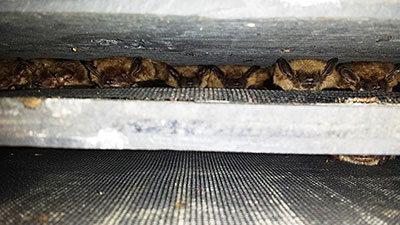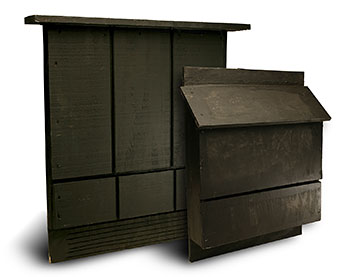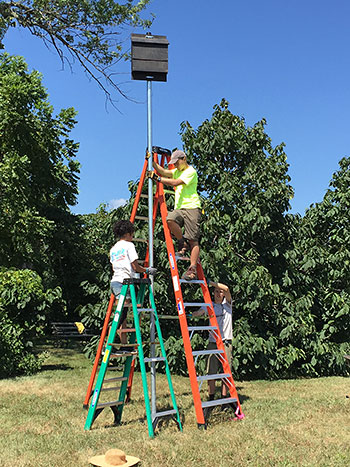Fact Sheet FS1269
Installing a bat roost box, or "bat house," on your property is an easy way to promote local wildlife conservation right in your backyard. However, bats are picky when it comes to finding a new home. This fact sheet provides the necessary guidelines and tips for properly installing a bat house so that you can attract these beneficial animals to your property and enjoy the natural insect pest control services they provide. A single adult bat can eat close to its body weight in insects every night! You'll also be helping bats to persist in the face of many significant threats, including habitat loss, mortality from wind turbines, and impacts from a fungal disease called White-Nose Syndrome.
Why Do Bats Use Roost Boxes?
A bat "roost" is the place bats use to rest and raise their young. In their natural habitat, bats roost in tree cavities, among leaves and under bark. But some species have adapted to roosting in man-made structures such as houses, barns, and bridges. These bats will occupy roost boxes, similar to birds using artificial nest boxes. Bat houses are constructed to mimic natural roosts by providing tight, vertical sheltered spaces in which bats can safely hang without being disturbed.
The two species that most commonly use bat houses in the northeast United States are big brown bats (Eptesicus fuscus) and little brown bats (Myotis lucifugus). During the spring and summer months, females roost together in "maternity colonies" to raise pups (Figure 1). Males may use bat houses to roost individually or in small groups.

Figure 1. Maternity colony of female big brown bats (Eptesicus fuscus) roosting in a manmade bat house. (Photo Credit: Mackenzie Hall)
Where Do I Get a Bat House?
You can purchase a bat house online or from a wildlife specialty store, or you can construct a bat house yourself. For either option, it is important to make sure that the bat house or design plans are certified by Bat Conservation International.
Bat houses come in many shapes and sizes, but bats prefer houses that are at least 2 feet tall and 14 inches wide (Figure 2). They can contain a single roosting chamber or multiple chambers separated by vertical partitions, but each chamber must be ¾ inch wide. Although bats will use singlechambered houses, larger bat houses with multiple chambers provide greater temperature diversity and can hold a larger colony size. The backboard of the bat house should extend 3–6 inches below the bottom of the roosting chambers to create a landing pad, which helps bats to safely access their roost. The landing pad and interior surfaces of the bat house must be roughly textured so bats can grip them. Small air vents, ½ inch wide on the front of the bat house allow for airflow.

Figure 2. Two bat house designs approved by Bat Conservation International.
Where Do I Install a Bat House?
Follow these three criteria to ensure that you have created the most attractive habitat for bats:
- Face the bat house south/southeast to attain maximum sun exposure (6–8 hours/day). Most bats need temperatures >85°F to retain body heat and keep young pups warm. Morning sun is best.
- If the climate is cool or dry, mounting boxes back-to-back on a pole or singly on a building will help buffer extreme temperature changes. This type of installation will provide options for bats to move in response to temperature fluctuations.
- In hot climates with average or high humidity, mounting boxes back-to-back with one facing north and one facing south may increase use. Different colors of houses can also be tested, using a darker color on the south facing box and a lighter color on the north facing box.
- Mount the bat house at least 12 feet off the ground. Higher is better. Bats swoop into and out of the bat house, and they need plenty of clearance to do so.
- Install in an area free of obstruction within a 20-foot radius. This maximizes exit clearance and minimizes predation by owls or other aerial predators.
- If possible, chose a location near a water body such as a stream, river, pond, or lake.

Figure 3. Installation of a pole-mounted bat house. (Photo Credit: Brooke Maslo)
Bat houses can be installed on the sides of buildings, poles, and dead trees ('snags').
Tree-Mounted Bat Houses
Bats are not likely to use bat houses mounted on live trees because foliage can block out the sun and branches can harbor predators. However, standing dead trees that receive full sun and are devoid of leaves and low branches can be appropriate.
Structure-Mounted Bat Houses
Bat houses mounted directly to a house, barn, garage, or other structure are most attractive to bats. This method eliminates drafts on one side of the bat house, providing a more stable temperature inside. Be careful not to mount the bat house underneath an eave or other structure that might create shade. And since bat houses are open at the bottom, be sure to choose a spot where you won't mind bat droppings below!
Pole-Mounted Bat Houses
A pole-mounted bat house is a good option if you cannot use a structure or there is no suitable dead tree on your property. However, it is also the most labor intensive and expensive of the three options and requires at least 3 people to install safely. We recommend using two 2-inch diameter, 10-foot galvanized metal pipes joined by a 2-inch galvanized metal coupling to create a 20-foot long mount. At least 20% of the entire pole, about 4 feet, should be cemented into the ground resulting in a bat house about 16 feet high. The bat house can be attached to the pole using two 2-inch U-bolts.
Location/Habitat
Suitable bat habitat contains a mixture of agricultural, forested, and urban landscapes in close proximity (~1/4 mile) of a water source. If using a pole mount, do not put the bat house in the middle of an open field, because there is no shelter from wind. Instead, mount the bat house 10–15 feet away from the tree line. Make sure there are no artificial lights directly shining onto your bat house, and no vents blowing air at the bat house.
When Is the Best Time to Install a Bat House?
In the spring, bats return from hibernation to their summer roost sites. Having the bat house in place prior to their arrival is ideal. If you are evicting bats from your home but would like to offer them an alternative roost site, install the bat house at least 2 weeks before the eviction. Doing so will give the bats time to explore and familiarize themselves with the bat house before they are excluded from their original roost.
How Long Will It Take for Bats to Find a Bat House?
It might take a few years for bats in the area to roost in a new bat house. There is a greater chance of occupancy if you follow the guidelines, and if you live near a mixture of habitat such as farmland, woods, and water. Bats are loyal to their summer roost and should return yearly once they take up residence in the bat house.
How Do I Maintain My Bat House?
Bat houses require very little maintenance, but should be checked every season for cracked seals or warping. Tightly sealed joints along the edges of the box help keep heat trapped inside. If you see any cracks, simply re-caulk them to fill in the holes. In some cases, wasps or other insects will make nests inside a bat house. These should be removed during the winter season. Never do work on the bat box or remove an insect nest while the bats are also using the box; wait until the winter when the bats have left for hibernation and the insects are inactive.
Providing Alternative Roosts for Evicted Bats
If you are performing a bat exclusion on your property, please consider providing an alternative housing option for your bats by installing a bat house. It is best to install the bat house as close as possible to the former roost location on your home. Make sure to follow state guidelines and safe dates when performing bat evictions so that bats are not harmed. Bats in New Jersey are protected under the NJ Endangered and Nongame Species Conservation Act, and it is illegal to kill or harass bats at any time. For more information on New Jersey Division of Fish and Wildlife's bat exclusion guidelines and safe dates please go to www.state.nj.us/dep/fgw/ensp/pdf/bat_control.pdf (PDF).
Rutgers Bat House Distribution Program
The Rutgers Wildlife Conservation and Management Program provides and installs free bat houses to homeowners who are getting a bat exclusion performed on their property. In exchange, we ask that homeowners enroll in our bat-monitoring program so we can evaluate the success of this initiative. For further information, please visit our website at wildlife.rutgers.edu or email us at wildlife@njaes.rutgers.edu.
February 2017
Copyright © 2024 Rutgers, The State University of New Jersey. All rights reserved.
For more information: njaes.rutgers.edu.
Cooperating Agencies: Rutgers, The State University of New Jersey, U.S. Department of Agriculture, and Boards of County Commissioners. Rutgers Cooperative Extension, a unit of the Rutgers New Jersey Agricultural Experiment Station, is an equal opportunity program provider and employer.

